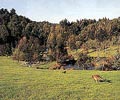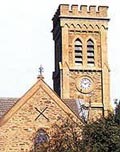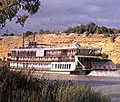The coastline south of Adelaide is rich and varied with beautiful beaches, magnificent coastal scenery, and abundant bird-life. There are very few commercial developments on the southeast's coastline and it is easy to find quiet, secluded beaches for swimming, surfing, fishing or walking.
Attractions in this region include Warrawong Sanctuary, Strathalbyn, Kangaroo Island, the Murray River, and Barossa Valley.
Warrawong Sanctuary
 Private owned, this sanctuary attempts to save rare animals from extinction by providing a natural and safe habitat in a 32 hectare area. Fifteen mammal species, many of them endangered, were introduced to this habitat and among them are bettongs, potoroos, and quolls. Warrawong Sanctuary is also the location of Australia's only successful platypus breeding program. Private owned, this sanctuary attempts to save rare animals from extinction by providing a natural and safe habitat in a 32 hectare area. Fifteen mammal species, many of them endangered, were introduced to this habitat and among them are bettongs, potoroos, and quolls. Warrawong Sanctuary is also the location of Australia's only successful platypus breeding program.
Guided walks are available throughout the day as well as accommodation and meals.
Strathalbyn
 Strathalbyn is a Scottish heritage town first settled in 1839. Association with its Scottish ancestry can still be witnessed throughout the town's architecture, which is reminiscent of small highland towns of Scotland. Strathalbyn is a Scottish heritage town first settled in 1839. Association with its Scottish ancestry can still be witnessed throughout the town's architecture, which is reminiscent of small highland towns of Scotland.
Distinguished heritage architectures include St. Andrew's Church, the 1858 police station, the 1865 courthouse, which is also home to the National Trust Museum, and the 1867 two-story London House, which was built as a general store. Many of these old buildings are now home to arts and crafts stores.
About 16km southeast of Strathalbyn, on the banks of the Bremer River, is Langhorne Creek, renowned as one of the earliest wine-growing regions in Australia.
Kangaroo Island
 Kangaroo Island is Australia's third largest island measuring 150km long and 30km wide. Located 16km off the Fleurieu Peninsula, it was the site of South Australia's first colonial settlement, which was established at Reeves Point. Kangaroo Island is Australia's third largest island measuring 150km long and 30km wide. Located 16km off the Fleurieu Peninsula, it was the site of South Australia's first colonial settlement, which was established at Reeves Point.
The island is sparsely populated and geographically isolated thus making it a haven for a wide variety of animals and birds, many of which are protected in its 19 conservation and national parks. At Kingscote and Penneshaw, fairy penguins can often be seen in the evenings. Seal Bay is home to a large colony of Australian sea lions. In Flinders Chase National Park, there are large numbers of friendly kangaroos that will often approach visitors to play with them. However, feeding is strictly discouraged.
The center of the island is dry but supports tracts of Mallee scrub and eucalypts. The coasts are perfect for swimming and at Kirkpatrick Point to the southwest stands a group of large rocks, named Remarkable Rocks for their weird and extraordinary formations caused by winds and sea erosion.
Little penguins are found around Australia's southern coastline and colonies are also present around the coastline of Kangaroo Island. These colonies are free from disturbance and require little protection. Colonies that are in close proximity to human settlements may experience higher levels of disturbance. However, the National Parks and Wildlife South Australian on Kangaroo Island is in charge of the protection of these little creatures, as well as educating the public on the correct ways of observing little penguins without disturbing them. Evening guided tours are available in Penneshaw and Kingscote colonies.
Murray River
 Australia's largest river, the Murray, is the major source of water to the local agricultural industry, which produces 40 percent of all Australian wine. This river also provides a source of water entertainment such as house-boating, water-skiing, cruises, and fishing. Australia's largest river, the Murray, is the major source of water to the local agricultural industry, which produces 40 percent of all Australian wine. This river also provides a source of water entertainment such as house-boating, water-skiing, cruises, and fishing.
At the heart of the Murray River irrigation area is the town of Renmark, home to the Riverlands' first winery. At the town's wharf is the restored paddlesteamer industry, now a floating museum and a reminder of the early days. South of Renmark is Berri, a commercial center and site of the largest combined distillery and winery in the Southern Hemisphere. The river continues to wind towards the small town of Luxton and then Waikerie before reaching the town of Morgan. The Port of Morgan Historical Museum is located here in the old railway station and tells the story of what was once the second busiest port in the state. The Mayflower, the oldest surviving paddlesteamer in the state, is moored next to the museum.
Top of Page |
